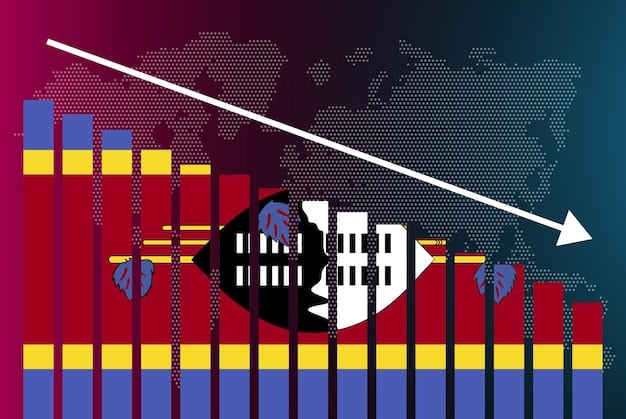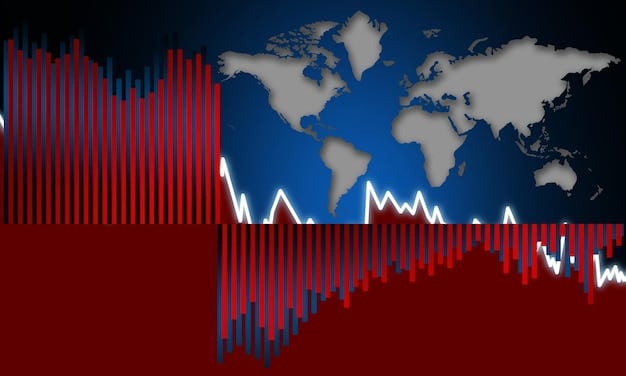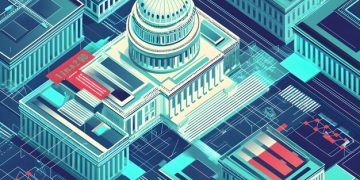Rising Global Debt Crisis: Potential Consequences for the US Economy

The potential consequences of the rising global debt crisis for the US economy include slower economic growth, increased financial market volatility, higher interest rates, and a potential decline in the value of the dollar.
Navigating the complexities of the global economy requires understanding the potential ripples of a **rising global debt crisis** on the stability and prosperity of the US economy. Let’s explore potential scenarios and their impacts.
Understanding the Global Debt Landscape
Before diving into the potential consequences for the US, it’s essential to grasp the current state of global debt and its contributing factors. Rising global debt is not a new phenomenon, but its scale and interconnectedness with various economies pose significant challenges.
Key Drivers of Global Debt
Several factors have contributed to the accumulation of global debt. These include expansionary monetary policies, increased government spending, and the globalization of financial markets.
- Low-Interest Rates: Prolonged periods of low-interest rates have encouraged borrowing by both governments and corporations.
- Fiscal Stimulus: Governments worldwide have increased spending to stimulate economic growth, especially in response to crises like the COVID-19 pandemic.
- Emerging Markets: Many emerging market economies have taken on significant debt to fund infrastructure projects and development initiatives.

Understanding these drivers is crucial for assessing the potential impact of a global debt crisis on the US economy. As debt levels continue to climb, the risk of defaults and financial instability increases, potentially triggering a cascade of adverse effects.
Slower Economic Growth in the US
One of the most significant potential consequences of a global debt crisis is a slowdown in US economic growth. The US economy is deeply intertwined with the global economy, making it vulnerable to external shocks.
Impact on Trade and Investment
A global debt crisis can disrupt international trade and investment flows, which are vital for the US economy.
- Reduced Exports: A slowdown in global economic activity can lead to decreased demand for US exports, impacting industries such as manufacturing and agriculture.
- Lower Foreign Investment: Investors may become risk-averse and pull back from investing in the US, reducing capital inflows and potentially increasing borrowing costs.
- Supply Chain Disruptions: A global debt crisis can disrupt supply chains, leading to higher costs and reduced availability of goods and services.
These factors can collectively dampen economic activity in the US, leading to slower growth and potentially even a recession. Additionally, decreased consumer confidence can exacerbate the slowdown, as individuals become more cautious about spending and saving.
Increased Financial Market Volatility
Heightened financial market volatility is another potential consequence of a global debt crisis. Instability in global markets can quickly spill over into US financial markets, creating uncertainty and impacting investor sentiment.
Flight to Safety
During times of crisis, investors often seek safe-haven assets, such as US Treasury bonds, which can lead to:
- Increased Demand for US Treasuries: This can push down yields on US government debt, potentially lowering borrowing costs for the government.
- Stock Market Declines: As investors sell off riskier assets, stock prices can fall, eroding wealth and confidence.
- Currency Fluctuations: The US dollar may strengthen as investors seek a safe currency, potentially making US exports more expensive and less competitive.

Increased volatility can also lead to margin calls, forced selling, and other destabilizing events, further exacerbating the crisis. Managing this volatility requires coordinated policy responses and effective communication strategies.
Higher Interest Rates in the US
A global debt crisis can put upward pressure on interest rates in the US. As investors become more risk-averse, they demand higher returns to compensate for the increased risk of lending.
Impact on Borrowing Costs
Higher interest rates can have several adverse effects on the US economy:
- Increased Mortgage Rates: This can make it more expensive for individuals to buy homes, dampening the housing market.
- Higher Corporate Borrowing Costs: Companies may delay or cancel investment projects, reducing economic activity.
- Increased Government Debt Burden: The cost of servicing government debt can rise, potentially leading to fiscal austerity measures.
The Federal Reserve may face a difficult balancing act, as it tries to manage inflation and support economic growth in the face of rising global debt. Raising interest rates too quickly could trigger a recession, while keeping rates too low could exacerbate inflationary pressures.
Potential Decline in the Value of the Dollar
A global debt crisis can also lead to a decline in the value of the US dollar. While the dollar often serves as a safe-haven currency, its long-term value can be undermined by factors such as:
Factors Affecting the Dollar’s Value
Several factors can contribute to a weakening dollar:
- Increased Government Debt: If the US government is perceived as being unable to manage its debt, investors may lose confidence in the dollar.
- Current Account Deficit: A persistent current account deficit can put downward pressure on the dollar, as the US must sell dollars to finance its imports.
- Geopolitical Risks: Increased geopolitical tensions can also lead to a flight from the dollar, as investors seek alternative safe-haven currencies.
A weaker dollar can have both positive and negative effects on the US economy. On the one hand, it can make US exports more competitive, boosting economic growth. On the other hand, it can increase the cost of imports, leading to higher inflation.
Policy Responses and Mitigation Strategies
Addressing the potential consequences of a rising global debt crisis requires a multipronged approach involving both domestic and international policy responses. Proactive measures can help mitigate the risks and support economic stability.
Domestic Policy Measures
The US government and the Federal Reserve can take several steps to mitigate the impact of a global debt crisis:
- Fiscal Prudence: Implementing responsible fiscal policies to manage government debt levels.
- Monetary Policy: Using monetary policy tools to maintain price stability and support economic growth.
- Financial Regulation: Strengthening financial regulations to prevent excessive risk-taking and maintain the stability of the financial system.
International Cooperation
International cooperation is also essential for addressing the global debt crisis:
- Coordination with International Institutions: Working with institutions like the International Monetary Fund (IMF) and the World Bank to provide assistance to countries facing debt crises.
- Bilateral Agreements: Establishing bilateral agreements with key trading partners to promote economic stability and cooperation.
- Debt Restructuring: Participating in debt restructuring initiatives to help countries manage their debt burdens.
By implementing these policy responses and mitigation strategies, the US can better navigate the challenges posed by a rising global debt crisis and protect its economic interests.
| Key Point | Brief Description |
|---|---|
| 📉 Slower Economic Growth | Reduced exports and foreign investment can slow down US economic activity. |
| 📈 Higher Interest Rates | Increased borrowing costs can dampen the housing market and corporate investments. |
| 💲 Dollar Value Decline | Increased government debt and current account deficits can weaken the US dollar. |
| 📊 Financial Market Volatility | Economic uncertainty globally can spill over into the US financial market, creating uncertainty. |
Frequently Asked Questions (FAQ)
▼
A global debt crisis occurs when multiple countries or entities struggle to repay their debts, leading to widespread financial instability and economic disruptions.
▼
It can impact the US economy through reduced exports, lower foreign investment, higher interest rates, and financial market volatility, leading to slower economic growth.
▼
Key drivers include prolonged periods of low-interest rates, increased government spending, particularly in response to crises, and the globalization of financial markets.
▼
Fiscal prudence, strategic monetary policy, strengthened financial regulations, and international cooperation with institutions like the IMF are vital strategies.
▼
Yes, increased government debt, current account deficits, and geopolitical risks can undermine confidence in the dollar, thus driving its devaluation on a global scale.
Conclusion
In conclusion, the potential consequences of a rising global debt crisis for the US economy are multifaceted and significant, encompassing slower economic growth, increased financial market volatility, higher interest rates, and potential decline in the dollar’s value. By understanding these risks and implementing proactive policy measures, the US can better navigate the challenges and protect its economic interests in an increasingly interconnected global economy.





